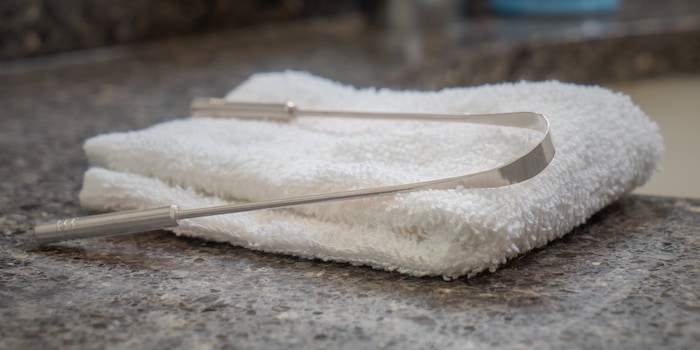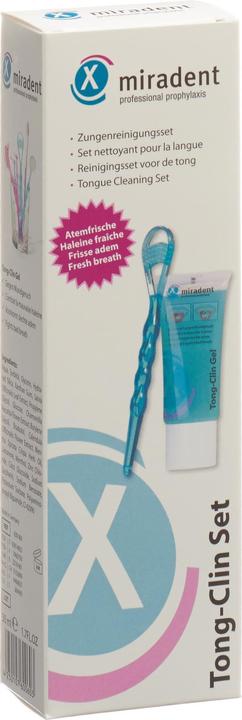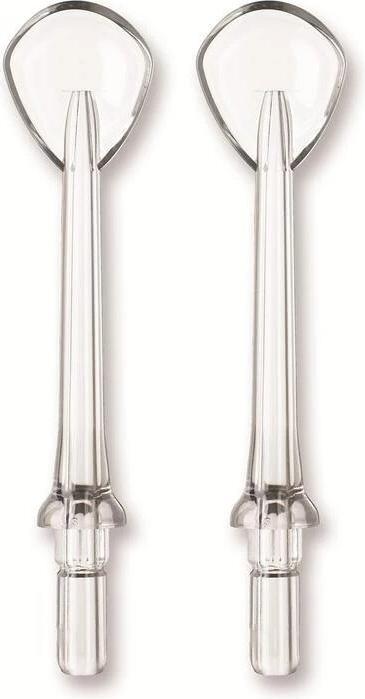
Meridol Safe Breath
Tongue scraper, 1 x

Brushing your teeth is a no-brainer. But what about your tongue? If you don’t scrub your tongue with a tongue brush and paste yet, you probably will after reading this article.
What would we do without the tongue? We could neither taste nor speak, couldn’t exchange French kisses or stick our tongue out at anyone. Admittedly, only kids do the latter – and adults in some regions of Tibet, for example in the area of Mount Kailash, where sticking out the tongue is a traditional greeting that was once invented by monks. By showing they don’t have a black tongue, people prove they belong to the «goodies». Ancient beliefs hold that only the devil has a black tongue.
By the way, the tongue is the only muscle in the human body that works without the support of the skeleton. In the tongue’s surroundings, the oral cavity, research has so far identified 700 different bacterial species, making the oral cavity the second largest microbial community in the body – after the gut. And like any microbiome, it’s an important part of our immune system.
Reason enough to understand that oral hygiene doesn’t only include brushing your teeth, but also tongue hygiene. By the way, at schools in the canton of Basel-Stadt, tongue cleaning is a compulsory part of the curriculum from the 3rd grade onwards and is part of the usual dental hygiene that’s taught by dental instructors.
You can easily tell if your tongue is healthy by having a look at it in front of a mirror. A healthy tongue is pink, moist and has no spots, furrows or white coating. White coating can have various causes, ranging from poor oral hygiene to aggressive mouth rinses with hydrogen peroxide, a high-carbohydrate diet or excessive alcohol and nicotine consumption. Another reason to eat a balanced diet.
Regardless of whether it’s flesh-coloured or whitish, the following applies to every tongue: «About 80 per cent of the bacteria in the mouth are located on the surface of the tongue,» says Viennese dentist Dr. Karin Vornwagner (website in German). As the tongue has a rough surface, bacteria can easily accumulate in oxygen-protected pits and niches. Embedded in a complex mucus layer of microorganisms, especially the «deep and adherent layers of this biofilm are an excellent habitat for gram-negative anaerobic microorganisms,» as the authors led by Prof. Dr. Andreas Filippi, a Basel-based specialist in oral surgery, write in this academic paper (in German).
These bacteria decompose organic material from food or saliva. However, they mainly feed on amino acids from dead mucosal cells under the tongue coating. As a result, sulphur compounds are formed, which, when combined with air, create bad breath. What’s known today is that those who suffer from halitosis (bad breath) have a bacterial density per unit area on the tongue that is up to 25 times higher (article in German) than people without halitosis. By the way, dentists often offer specific halitosis consultations (site in German).
But even if you don’t suffer from bad breath, how do you get rid of that coating on your tongue? The biofilm, which is populated with lots of gram-negative anaerobic bacteria, «can’t be sufficiently influenced from the outside by reducing or changing the diet,» as described in the paper by Filippi et al. «Chemical substances in mouth rinses, lozenges or chewing gums don’t penetrate the biofilm sufficiently, either. The only effective measure – as with the biofilm on the teeth – is regular tongue cleaning.»
According to studies, brushing the tongue regularly doesn’t reduce bacteria counts, but can reduce tongue coating – and thus bad breath. After all, cleaning the tongue eliminates the volatile sulphur compounds that anaerobic bacteria produce. The scientists also found that cleaning the tongue regularly improves the sense of taste, especially with older people.
There are various tools to clean the tongue. You could even use a conventional toothbrush. Some toothbrushes are equipped with a tongue cleaner on the opposite side of the bristles. The problem, however, is that most of the tongue coating is on the back third of the tongue. That part is difficult to reach with a regular toothbrush without triggering the gag reflex, as the high brush head could touch the uvula. In addition to this, the surface of a toothbrush is too small and the bristles are too soft to clean the tongue thoroughly.
Therefore, experts recommend using brushes that are specially designed for tongue cleaning. They look similar to toothbrushes, but have a flat brush head, with either short bristles or lamella.

Meridol Safe Breath
Tongue scraper, 1 x


Miradent Tong-Clin Set
Tongue scraper, 1 x
The other type of tongue cleaners are tongue scrapers, which come in various designs. Some are spoon shaped, some have a kind of loop to scrape the tongue, others look like a round V or a V-shaped U.

Trisa double action
Tongue scraper, 1 x

Quick Aid Tongue cleaner
Tongue scraper, 1 x

However, based on the latest state of research, specialists such as Filippi no longer recommend these tongue scrapers without reservation. «They can only remove the upper layers of plaque and don’t reach the gram-negative anaerobes in the depths of the epithelium. This also explains why the effect after using tongue scrapers lasts significantly shorter than after cleaning it with a tongue brush,» he writes in his compendium «Halitosis. Professional treatment of halitosis in dental practice» (in German). He also states that the risk of injury is much greater with tongue scrapers.
In addition to a special tongue brush, Filippi recommends using tongue paste to make the cleaning effect last longer.
Cleaning your tongue is very similar to brushing your teeth. You massage in the paste and scrub it off. That’s it. However, it takes some practice and you might need a mirror, at least at the start.
First, stick your tongue out as far as you can and gently massage in the special tongue paste with the tongue brush. Be sure not to start too far back – no further than the highest point of the tongue – to prevent injuring the surface of the tongue.
Now massage in the paste with the brush and then scrape off the foam from the back to the front. Expert Vornwagner says, «It’s best to use the tongue cleaner in the morning after getting up, but before brushing your teeth.» That’s because it allows you to easily scrape off food leftovers that are deposited on the tongue in the course of the night. In the case of bad breath that has oral causes, cleaning your tongue is recommended up to three times a day.
It’s quite possible that scraping your tongue triggers a gag reflex. «My tip is to concentrate and breathe through your nose,» says dentist Vornwagner. What also helps is closing your eyes while you’re scraping and/or holding the tip of your tongue. And last but not least, the saying «practice makes perfect» also applies to cleaning your tongue. If you clean your tongue regularly, it won’t make you gag anymore and you’ll create the best conditions for an all-around healthy oral cavity. Expert Filippi’s compendium states: «There is increasing evidence that tongue cleaning also has a caries-protective effect and can positively influence the treatment of marginal periodontitis and periimplantitis.» In other words, cleaning the tongue regularly gives you better breath, offers protection against tooth decay and can help with gum infection.
Header image: Shutterstock
The adjectives that describe me? Open-minded, pensive, curious, agnostic, solitude-loving, ironic and, of course, breathtaking.
Writing is my calling. I wrote fairytales age 8. «Supercool» song lyrics nobody ever got to hear age 15 and a travel blog in my mid-20s. Today, I’m dedicated to poems and writing the best articles of all time.
Interesting facts about products, behind-the-scenes looks at manufacturers and deep-dives on interesting people.
Show all